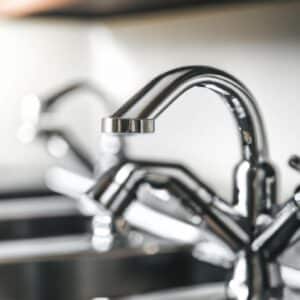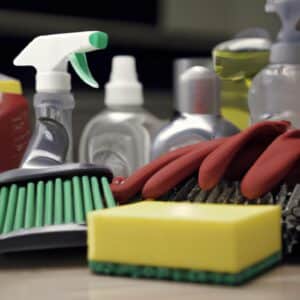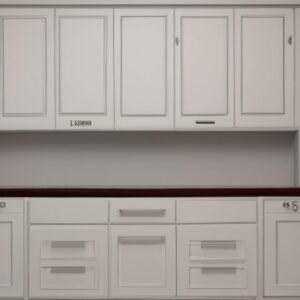Keeping your kitchen floor tiles clean can feel like a chore, but it can be a breeze with the right products and a few simple steps! Ceramic and porcelain kitchen tiles are famous for their durability and low-maintenance upkeep. Still, regular cleaning is essential to keep them looking their best. In this article, we’ll cover all you need to know about how to clean kitchen floor tile, including ceramic and porcelain floor tiles, so you can return to cooking in a sparkling, spotless kitchen!
For an overview, you can watch this video on cleaning kitchen tiles:
Understanding Your Tiles
Before you can begin cleaning your kitchen floor tiles, you must understand what ceramic or porcelain tiles you have and the best solution to clean them. Ceramic and porcelain tiles are popular, durable, and versatile materials used in many homes around the world. They can be made from various materials, including clay, glass, and stone, and each requires a different type of cleaning solution. Choosing the right cleaning solution for the type of tile is essential to ensure it is cleaned properly and safely.
The best cleaning solution for ceramic and porcelain tiles is typically warm or hot water with mild detergent. However, for more challenging jobs, you can also use a soapy water mixture, a grout cleaner, white vinegar, hydrogen peroxide, or other acidic cleaners. Be sure to avoid using acidic cleaners on natural stone tiles. Additionally, it is essential to ensure you are using the right cleaning tools, such as a damp cloth or a scrub brush for tougher stains.
Getting Ready to Clean
Before you start cleaning your kitchen floor tiles, it is essential to prepare the necessary materials. Gather a bucket, a mop, a damp cloth, a scrub brush, and a cleaning solution of your choice. You can make a cleaning solution by mixing hot or warm water with grout cleaner, white vinegar, dish soap, hydrogen peroxide, or any other acidic cleaners. Depending on your kitchen size, you may need more than one bucket of cleaning solution. Once everything is gathered, it’s time to start cleaning.
Cleaning tiles can be a labor-intensive job, so make sure you are wearing the appropriate clothing and safety gear. For example, wear shoes that protect your feet from heat if you are cleaning with a steam mop. Also, wear gloves to protect your hands from harsh chemicals in the solution.
How to Clean Kitchen Floor Tile?
Cleaning your kitchen floor tiles can seem daunting, but it’s not as difficult as it seems. With the right cleaning supplies and some elbow grease, you can quickly and easily keep your kitchen floor tiles looking spotless. Here’s what you need to do:
Start by gathering all the necessary cleaning materials – a mop, bucket, warm water, a cloth, and a scrub brush. You might need a grout cleaner and a more powerful acidic cleaner like white vinegar, dish soap, or hydrogen peroxide if you have stubborn stains.
Next, prepare a cleaning solution of warm water and your chosen cleaner. You don’t want to use anything too harsh or abrasive on your tiles, so make sure you use a gentle cleaner.
When you’re ready, use a damp cloth to clean your tiles. If there are any tough stains you need to remove, use a scrub brush to get them out. Work in small sections and use your scrub brush gently. Once you’re done, rinse off the floor with clean water.
You can mix a soapy water mixture for more demanding jobs and use it to clean the tiles. If you want to do a deep cleaning, use a steam mop or cleaner.
Avoid using acidic cleaners on natural stone tiles, as they can damage them. Once you’re done cleaning, use a dry cloth to dry off the tiles and prevent water spots.
Regular cleaning of your kitchen floor tiles is essential to keep them looking fresh and spotless. With the proper knowledge and supplies, you can learn how to clean kitchen floor tiles easily and quickly.
Additional Cleaning Tips
It’s easy to keep your kitchen floor tiles shining and spotless, but sometimes extra effort is needed. For more demanding jobs, a soapy water mixture is your best bet. Use a cloth or scrub brush to wipe away dirt and residue, and rinse the tiles with clean water. You can also use a steam mop or steam cleaner for a deep clean.
When choosing a cleaning solution, knowing what type of tile you have in your kitchen is essential. Avoid using acidic cleaners on natural stone tiles since they can cause damage. Otherwise, white vinegar, dish soap, hydrogen peroxide, and other acidic cleaners can effectively remove stubborn dirt and stains.
For the best results, dry the tiles with a clean cloth after cleaning and regularly clean them to prevent buildup and water spots. You can easily keep your kitchen floor tiles looking fresh and spotless with some extra effort.
Cleaning and Preventing Water Spots
Cleaning your ceramic and porcelain kitchen tiles effectively can be a challenge. To keep your tiles looking fresh and spotless, it’s essential to use the right cleaning solutions. White vinegar, dish soap, hydrogen peroxide, or other acidic cleaners can tackle tough stains. Steam cleaning or a steam mop can also be used for an effective deep clean. Make sure to dry the tiles with a clean cloth after cleaning to avoid any water spots. Regularly cleaning your tiles will help prevent any buildup or water spots from forming. With the right cleaning products and a bit of effort, you can easily keep your kitchen tiles looking like new.
Conclusion
In conclusion, keeping ceramic and porcelain kitchen floor tiles clean is an easy process that requires basic materials and a few simple steps. Firstly, it is essential to determine what type of tile is being cleaned before selecting the appropriate cleaning solution. After gathering the necessary cleaning materials, choosing either hot or warm water before cleaning the tiles with a damp cloth and scrubbing away any stubborn stains is essential.
A soapy water mixture may be used for more demanding jobs or a steam mop or cleaner. It is also essential to avoid using acidic cleaners on natural stone tiles and to use white vinegar, dish soap, hydrogen peroxide, or any other acidic cleaners to clean and prevent water spots. Finally, it is essential to dry the tiles with a clean cloth after cleaning and regularly clean them to ensure they look fresh and spotless. With these tips in mind, keeping your kitchen floor tiles clean should be an effortless task that can be accomplished quickly!





